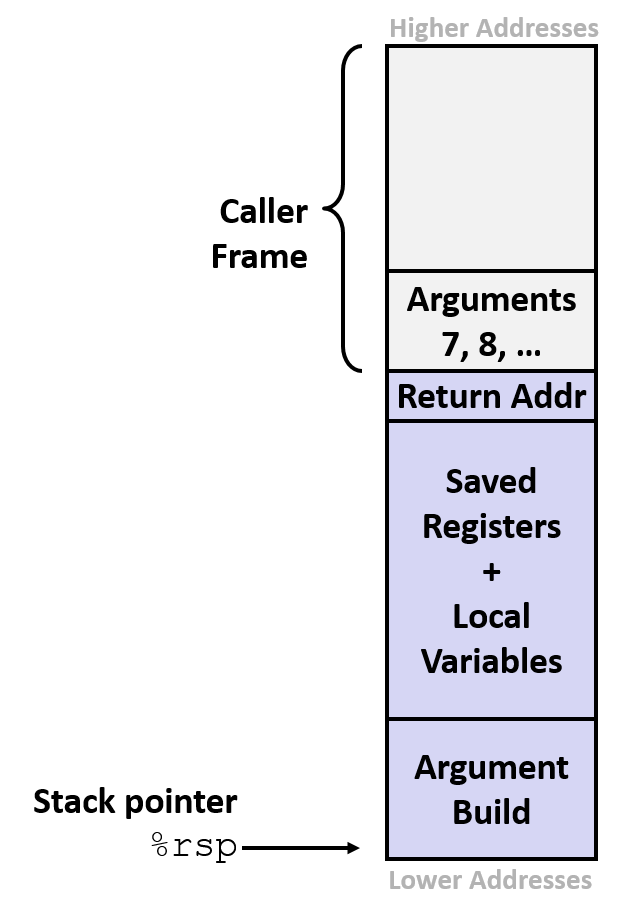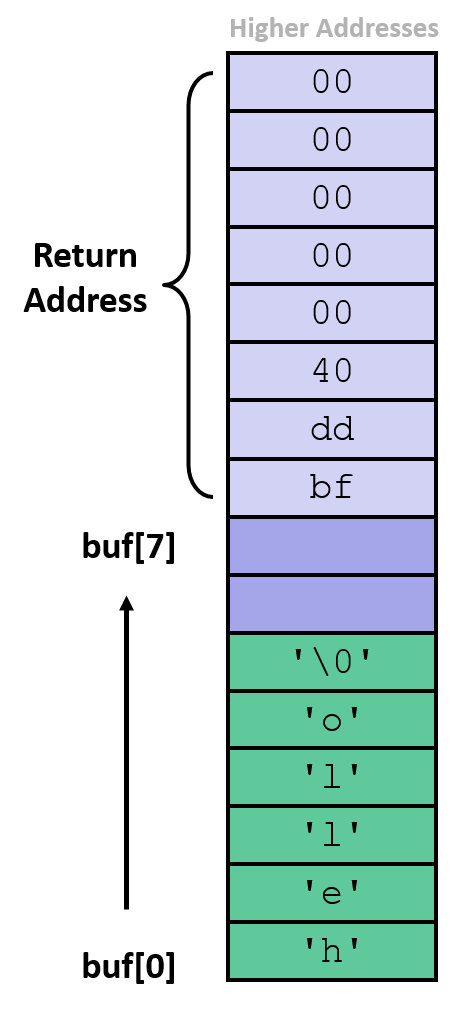CS 208 w20 lecture 15 outline
1 Review
#include <stdlib.h>
struct s {
char c;
int a[4];
char *p;
};
int get_elem(struct s *sp, long index) {
return sp->a[index];
}
int main() {
struct s *sp = malloc(sizeof(struct s));
return get_elem(sp, 3);
}
Which instruction (plus ret) implements getelem?
2 Background
2.1 Stack Frame Review
- In x86-64 Linux
- stack segment of memory starts at
0x00007fffffffffffand grows down - code segment of memory starts at
0x400000and grows up
- stack segment of memory starts at

2.2 What is a Buffer?
- array used to temporarily store data
- video buffering is the video being written to a buffer before being played
- often used to store user input
2.3 What is a Buffer Overflow?
- arrays can be stored on the stack alongside procedure data like the return address
- C does not prevent writing to elements beyond the end of an array
- together, these two facts allow for a buffer overflow where program state on the stack is corrupted
- for example, overwritting the return address pushed on the stack by the caller would cause the program to jump to an unexpected or invalid place


- attacker just has to choose the right inputs to overwrite interesting data
- simple attack: overwrite the current return address (sometimes called stack smashing)
- for a long time this was the #1 technical cause of security vulnerabilities
- #1 overall cause is pretty much always humans (social engineering, ignorance, etc.)
2.3.1 Example
/* Get string from stdin */
char* gets(char* dest) {
int c = getchar();
char* p = dest;
while (c != EOF && c != '\n') {
*p++ = c;
c = getchar();
}
*p = '\0';
return dest;
}
- what could go wrong here?
2.3.2 gets Known to be Harmful
- bugs section of
getsman page - also a problem with
strcpy,scanf,fsnanf,sscanf gcc: warning: the `gets' function is dangerous and should not be used.
3 Buffer Overflow In Action
Consider this (very insecure) code:
/* Echo Line */
void echo() {
char buf[8]; /* Way too small! */
gets(buf);
puts(buf);
}
void call_echo() {
echo();
}
- entering
01234567890123456789012works fine - entering
012345678901234567890123causes an illeagal instruction error - entering
0123456789012345678901234causes a segmentation fault
From buf-nsp.d:
0000000000400566 <echo>: 400566: 48 83 ec 18 sub $0x18,%rsp 40056a: 48 89 e7 mov %rsp,%rdi 40056d: b8 00 00 00 00 mov $0x0,%eax 400572: e8 d9 fe ff ff callq 400450 <gets@plt> 400577: 48 89 e7 mov %rsp,%rdi 40057a: e8 b1 fe ff ff callq 400430 <puts@plt> 40057f: 48 83 c4 18 add $0x18,%rsp 400583: c3 retq 0000000000400584 <call_echo>: 400584: 48 83 ec 08 sub $0x8,%rsp 400588: b8 00 00 00 00 mov $0x0,%eax 40058d: e8 d4 ff ff ff callq 400566 <echo> 400592: 48 83 c4 08 add $0x8,%rsp 400596: c3 retq
4 Code Injection Attack

- very common attack to get a program to execute an arbitrary function
- over a network, program given a string containing executable code (exploit code) with extra data to overwrite a return address with the location of the exploit
- exploit might use a system call to start a shell giving the attacker access to the system
- exploit might do some mischief, then repair the stack and call
retagain, giving the appearance of normal behavior
4.1 Poll
vulnerable:
subq $0x40, %rsp
...
leaq 0x10(%rsp), %rdi
call gets
...
What is the minimum number of characters that gets must read in order for us to change the return address to a stack address?
For example, change 0x00 00 00 00 00 40 05 D1 to 0x00 00 7F FF CA FE F0 0D
4.2 Real World examples
- buffer overflow exploits are alarmingly common in real programs
- programmers keep making the same mistakes
- recent innovations have improved the situation
4.2.1 Internet Worm (1988)
- protocol for getting the status of a server (
fingerd) usedgetsto read its argument - worm sent exploit code that executed a root shell on the target machine
- scanned other machines to attack, invaded about 6000 computers in hours (10% of the Internet at that time)
- see June 1989 article in Comm. of the ACM
- author (Robert Morris) was first person ever convicted under the Computer Fraud and Abuse Act, now faculty at MIT
4.2.2 Heartbleed (2014)

- affected Tumblr, Google, Yahoo, Intuit (makers of TurboTax), Dropbox, Netflix, Facebook, and many, many smaller sites
4.2.3 Hacking Cars
- in 2010, UW researchers demonstrated wirelessly hacking a car using buffer overflow
- overwrote the onboard control system’s code
- disable brakes
- unlock doors
- turn engine on/off
4.2.4 Hacking DNA Sequencing Machines
- in 2017, security researchers demonstrated that a buffer overflow exploit could be encoded in DNA
- when read by vulnerable sequencing software, the attack could compromise the sequencing machine
5 Countermeasures
5.1 System Level
5.1.1 Non-Executable Stack
x86-64 added execute permission (not all systems have hardware support, doesn't block all exploits)
5.1.2 Stack Randomization
- in the past, stack addresses were highly predictable, meaning if an attacker could determine addresses for a common web server, than many machines were vulnerable
- make it unpredictable by allocating between 0 and \(n\) bytes on the stack at the start of the program
- part of a larger class of techniques called address-space layout randomization (ASLR)
- in general, this randomization can greatly increase the effort required for a successful attack, but cannot guarantee safety
5.2 Writing Better Code
fgets, strncpy, avoid %s use safer language
5.2.1 Stack Corruption Detection
- detect when stack corruption occurs before it can have harmful effects
gccnow uses stack protectors to detect buffer overflows- canary value (or guard value) between buffer and rest of the stack
- generated each time the program runs, so hard for attacker to know what it will be
- stored in a read-only segment of memory
- prevents many common attack strategies